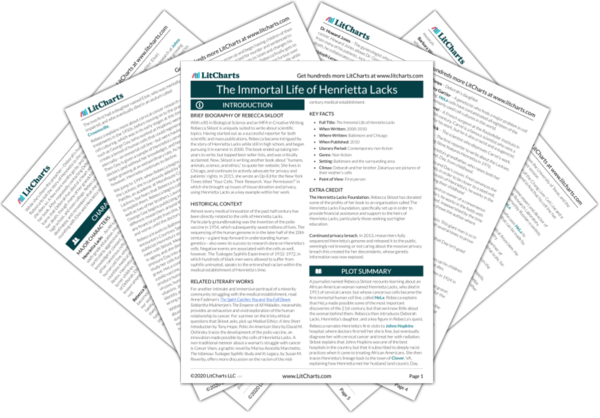HeLa
HeLa is the cell line that comes from Henrietta Lacks. It is “immortal”—meaning that it can continue to regenerate indefinitely if given nutrients and space to grow. To scientists, HeLa represents essentially endless possibility…
read analysis of HeLaStatue of Jesus
In front of Johns Hopkins is a statue of Jesus, the toe of which patients and doctors alike rub for luck. For Rebecca Skloot, the statue represents the intersection of medicine and religion—two vital…
read analysis of Statue of JesusJohns Hopkins
Like many symbols within the book, the research university and hospital of Johns Hopkins is a double-edged sword. Founded specifically to help the poor and minorities, it emblemizes cutting-edge medical advances and high quality of…
read analysis of Johns HopkinsClover and Lacks Town
Clover and Lacks Town, where Henrietta Lacks grew up, represent a bygone era for Rebecca Skloot. She sees both the idyllic, pre-industrial side, as well as the deep racial divides that lie underneath its…
read analysis of Clover and Lacks TownHenrietta’s Fingernails and Toenails
Henrietta’s relatives all remember her pristine fingernails and toenails, which she kept painted a vibrant red. Indeed, her female cousins only understood how sick she was once they saw how chipped her nails were…
read analysis of Henrietta’s Fingernails and Toenails
Tuskegee Institute
Of all the symbols within the book, the Tuskegee Institute has one of the most dramatically double-sided legacies. On one hand, Tuskegee was the site of the cell-production factory where a staff of black, female…
read analysis of Tuskegee InstituteCrownsville State Hospital
Elsie Lacks’ family sent her to Crownsville (formerly known as the Hospital for the Negro Insane) after it became impossible to keep her safe and healthy at home. During the 1950s, however, Crownsville was…
read analysis of Crownsville State Hospital






